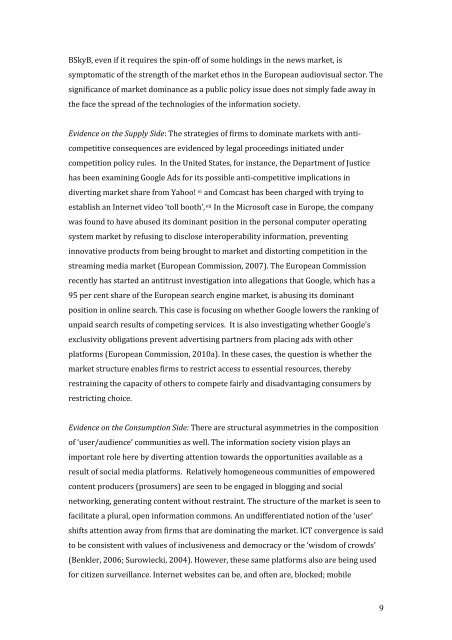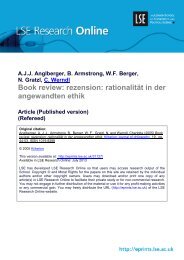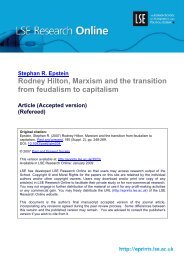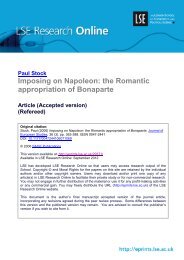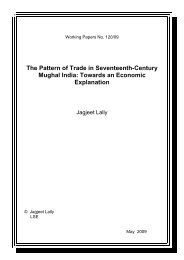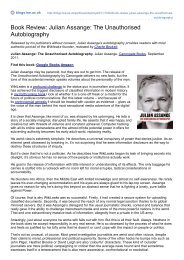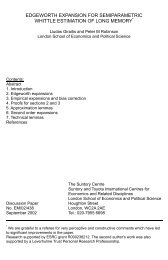Download (307Kb) - LSE Research Online
Download (307Kb) - LSE Research Online
Download (307Kb) - LSE Research Online
Create successful ePaper yourself
Turn your PDF publications into a flip-book with our unique Google optimized e-Paper software.
BSkyB, even if it requires the spin‐off of some holdings in the news market, is<br />
symptomatic of the strength of the market ethos in the European audiovisual sector. The<br />
significance of market dominance as a public policy issue does not simply fade away in<br />
the<br />
face the spread of the technologies of the information society.<br />
Evidence on the Supply Side: The strategies of firms to dominate markets with anti‐<br />
competitive consequences are evidenced by legal proceedings initiated under<br />
competition policy rules. In the United States, for instance, the Department of Justice<br />
has been examining Google Ads for its possible anti‐competitive implications in<br />
diverting market share from Yahoo! vi and Comcast has been charged with trying to<br />
establish an Internet video ‘toll booth’, vii In the Microsoft case in Europe, the company<br />
was found to have abused its dominant position in the personal computer operating<br />
system market by refusing to disclose interoperability information, preventing<br />
innovative products from being brought to market and distorting competition in the<br />
streaming media market (European Commission, 2007). The European Commission<br />
recently has started an antitrust investigation into allegations that Google, which has a<br />
95 per cent share of the European search engine market, is abusing its dominant<br />
position in online search. This case is focusing on whether Google lowers the ranking of<br />
unpaid search results of competing services. It is also investigating whether Google’s<br />
exclusivity obligations prevent advertising partners from placing ads with other<br />
platforms (European Commission, 2010a). In these cases, the question is whether the<br />
market structure enables firms to restrict access to essential resources, thereby<br />
restraining the capacity of others to compete fairly and disadvantaging consumers by<br />
restricting<br />
choice.<br />
Evidence on the Consumption Side: There are structural asymmetries in the composition<br />
of ‘user/audience’ communities as well. The information society vision plays an<br />
important role here by diverting attention towards the opportunities available as a<br />
result of social media platforms. Relatively homogeneous communities of empowered<br />
content producers (prosumers) are seen to be engaged in blogging and social<br />
networking, generating content without restraint. The structure of the market is seen to<br />
facilitate a plural, open information commons. An undifferentiated notion of the ‘user’<br />
shifts attention away from firms that are dominating the market. ICT convergence is said<br />
to be consistent with values of inclusiveness and democracy or the ‘wisdom of crowds’<br />
(Benkler, 2006; Surowiecki, 2004). However, these same platforms also are being used<br />
for citizen surveillance. Internet websites can be, and often are, blocked; mobile<br />
9


